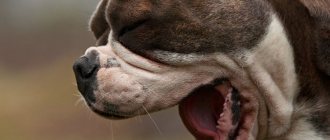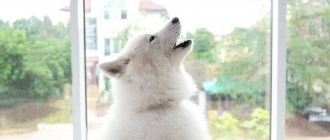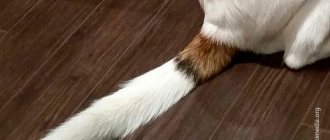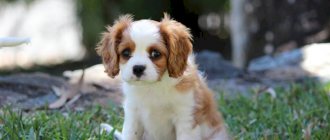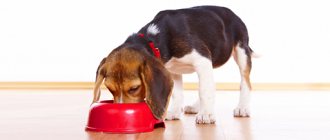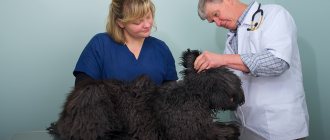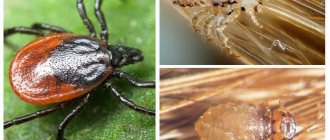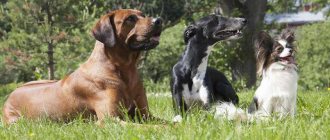Dogs are guards and it is their direct responsibility to show aggression towards uninvited guests. But sometimes the situation gets out of control, and the dog growls at the owner.
Unfortunately, owners often do not try to understand the situation, especially when it comes to large animals, and immediately get rid of their pet, fearing serious consequences.
But there is always a reason for such behavior, and it is not always associated with anger.
What can cause such a reaction and, most importantly, how to discourage your pet from this bad habit?
What is the reason for this behavior?
A dog can not only growl, but also demonstrate his negative attitude in other ways - bare his teeth, bark, or not complete the task given to him.
An angry animal may be overly protective of its bowl, toys, or other objects that the pet considers to be its own.
In addition, the dog can show excessive dissatisfaction during hygiene procedures that it especially does not like, for example, when trimming its nails, combing its fur, or using a trimmer.
But sometimes such behavior is not a sign of aggression, it signals that the pet is confused, afraid or feels defenseless.
Reasons for behavior
As puppies, dogs instinctively bite to test the strength of their bite. This is how relationships within the pack are established. If, after the baby closes his jaws, he hears a squeal or scream in response, then the next time the bite will most likely be weaker.
The owner feeds and takes care of the pet, but then it is not clear why the dog bites the owner’s hands. The fact is that the dog considers him a member of the pack. She chooses this method in order to attract attention and force him to play.
During the game, you should not allow a situation where the dog bites the owner. Any attempt should be stopped. During play, the animal becomes excited, so it can bite even harder, but it should not be pushed away. The pet will regard this as part of the game. If this kind of play is not stopped, the behavior may become aggressive.
How can you find out the cause of the growling?
Experts identify several situations that can provoke growling, anxiety and other emotions in a dog:
The dog considers himself the master of the house.
Representatives of many breeds have a tendency to dominate, which they often display when communicating with family members and other pets.
Often it is the spoiled individuals who become leaders, as the owner makes the mistake of trying in every possible way to please his four-legged friend.
The animal begins to be jealous of its things - food, toys, not allowing the owner to approach and take them.
In addition, the dog can also encroach on objects that do not belong to him. With a growl, he declares his rights and confirms that there is only one owner in the house!
Dog responds to cruelty with aggression
In this case, the situation is the opposite - the pet is constantly faced with cruelty directed at it, and the growling becomes a warning signal - not to approach.
This behavior is called fear aggression.
A dog may also growl when it is being punished or scolded for misbehavior or for no reason.
A dog shows a sense of ownership by growling.
This behavior is typical of teenage males, who not only grow and become stronger, but also try to assert themselves. During this period, many owners are faced with the fact that an obedient and flexible dog suddenly becomes uncontrollable.
This happens due to natural instincts - the animal shows its leadership qualities, and the goal of such behavior is one - to become a leader. In addition to growling, the dog can violate previously established boundaries, occupying forbidden territory.
Most often, it serves as the owner’s sleeping place. At the same time, we are not talking about any fear; with all his appearance, the male shows his fearlessness and confirms his importance.
Food aggression
In this situation, the puppy may snatch the treat, biting the hand, and the puppy may growl when the owner pets him while eating.
An adult dog may grin or freeze while eating food if the owner comes too close or reaches out to the bowl. This behavior can be corrected; there are several methods for this.
Aggression of a puppy bitch
A mother always tries to protect her offspring - this is a strong innate instinct that helps bitches ensure the safety of their babies.
During this period, she can show anger towards other bitches, even for no apparent reason. And keep the owner away from the puppies at home, but most often this only applies to children.
Reaction to pain
Dogs, especially those that are overly independent and active, are often injured, receiving external or internal injuries.
Sometimes the owners don’t even know about it, or the dog has no visible wounds. Naturally, when touched, the pet may growl, move away, and whine.
In almost all of these situations, except for the dominant manifestation, there is an irritant that provokes the dog.
But the most difficult thing to correct is the errors of upbringing, in which the dog allows itself to behave inappropriately towards the owner.
Briefly about the main thing
- Punishment, or negative reinforcement, is an important part of education and training.
- The reaction to aggression, damaged things and disobedience must be immediate.
- The main methods of punishment: severe reprimand, ignoring, shaking the withers.
- Even if a dog exhibits destructive behavior, it should not be beaten, starved, or deprived of companionship for a long time.
- Due to their developmental characteristics, puppies can relieve themselves in the house and chew on objects. With the right approach, this behavior goes away by 4-6 months.
Punishment is one of the most difficult aspects of raising a dog. Share your proven methods in the comments.
Why does a dog develop dominant behavior and how does it manifest itself?
Dogs have been living next to humans for thousands of years, but at the same time, in essence, retain their pack behavior. Only they mistake the owner and household members for a flock.
With proper upbringing, the dog perceives the owner as a leader; he must obey him. Both the pet and other family members must obey the leader.
If the puppy was not immediately shown who is boss in the house, then he perceives this as an opportunity to make his own choice. Naturally, he will appoint himself to this position, happily becoming the leader of the pack, and his behavior will be appropriate.
The leader's behavioral line develops gradually, starting with a little disobedience. The dog does not follow commands the first time, waiting and assessing the owner’s reaction. There is no question of any aggression in this case.
Is it worth punishing with your hands?
For the same reason, most dog trainers do not recommend using your hands even for light spanks. They believe that only good things should come from hands - affection, food, treats. True, it is on this issue that opinions are ambiguous. Some, when advising on how to punish a dog, suggest lightly spanking it on the rump with your hand. However, even they agree that the dog itself should not see the moment of impact. And it is absolutely unacceptable to swing your hand wide at your pet before striking in order to provoke additional fear in him.
But shaking the dog by firmly grasping the scruff of the neck with your hand is very effective. This is exactly how a mother teaches her offspring in nature. Therefore, this method of training is most effective for puppies. But they should not be abused either. Punishment must always be proportionate to the offense. It is quite appropriate to shake a naughty puppy who, having played out, bit his owner too hard. But every time you bother the kid, teaching the command “fu!” obviously not worth it.
What signs of dominant dog behavior should alert an owner?
- the dog has the audacity to go to bed in the owner’s place, and when he tries to drive him away, he begins to growl and bite;
- is the first to rush to dinner, demanding tidbits (according to the rules, the dog should be fed only after all other family members have eaten);
- drags food into the room and, again, when such behavior is stopped, begins to grin and growl;
- when guests come to the house, the dog’s behavior can be unpredictable - it can show curiosity, aggression, and at the same time the owner is not able to calm the pet down and remove it from the premises;
- when walking, the dog does not walk alongside, but always strives to move in front;
- does not listen to commands, performs carelessly, tries to play as much as possible during classes, obsessive behavior is observed.
Dogs often perceive the superiority of adult family members, but children are considered equal to themselves or are classified as having an even lower rank.
Naturally, with such an attitude, the dog can growl at them, bare their teeth and bite, even in cases where the dog does not allow such behavior with adults.
Most often, kids are not an “authority” for a pet, especially those who appeared in the house later than the animal or when parents allow themselves to raise their voices at the child in the presence of a dog.
What to do if a dog growls at its owner
The cat attacks the owner: the main reasons and options for what to do
A disobedient dog will not be able to live in a pack, because the leader is always able to prove his superiority to all his relatives at the same time. A willful pet must also understand that on the ladder of the family hierarchy he is the lowest. To do this, dog experts recommend the following techniques:
- the dog should never be fed before all family members have eaten;
- the animal for a walk should be the last to leave the door, and not ahead of everyone else;
- You should always look at the beast from above, you should never go down to the level of his eyes;
- as a last resort, it is necessary to use the wolf method of forcing submission, when the leader of the pack lightly strangles the offending animal by the neck and presses it to the ground. If a member of the pack resists, the offender is lifted by the scruff of the neck and strangled again. This is repeated until the wolf goes limp, thereby showing that he has admitted defeat.
Important! The process of coercing a pet based on the principle of relationships in a wolf pack can only be carried out after the dog is muzzled.
To demonstrate the superiority of a person over an animal, it is permissible to use special accessories - reins-noose, on which you can lift the dog and shake it in case of disobedience or aggression.
A small animal can be put into a submission position by turning it upside down with its belly. In this position, the dog is given a suggestion in a stern voice. If the animal froze and squealed, it means it recognized the primacy of the owner. The animal may begin to caress, but you cannot show that the owner has stopped being angry with him. The dog must leave the place of punishment first.
Walking the dog must be muzzled
The process of re-education
No matter what causes a dog to growl at its owner and other family members, such behavior must be dealt with. After all, according to statistics, about 80% of pets that allow themselves to behave this way are capable of biting a person.
If anger is not associated with a disease of the central nervous system, injuries or other pathological conditions, then you should start raising the presumptuous pet.
When working with overly aggressive dogs, experts recommend using an ultrasonic whistle. Its sound is so unpleasant to the ears of animals that the dog stops growling and grinning, just so as not to hear it anymore.
Gradually, he will begin to understand that his influence is associated with inappropriate behavior and will understand who is in charge in the house. In this case, the necessary reflexes are triggered.
When choosing re-education methods, you must take into account the type of aggression, habits and temperament of your pet. And if such behavior occurs in serious, large dogs, then it is best to contact a dog handler who knows the breed characteristics and has experience working with such dogs.
A large, strong pet is a big responsibility and it’s not worth risking the health of yours and your loved ones.
But, regardless of the size of the pet, it is important for the owner to restore his authority by becoming a real leader. The dog, of course, will not immediately accept the new state of affairs and will resist, but by showing patience, endurance and fortitude, the person will be able to normalize the situation.
Otherwise, a dog of a guard or fighting breed may become a threat to others. And if a person initially does not have a strong character and does not have experience in communicating and raising such animals, then the idea of having such a pet should be immediately abandoned.
To restore the hierarchy, it is important for the owner to know the leverage points and take control over them. This includes the process of feeding, affection, reward and punishment.
When should you contact a specialist?
The help of a specialist is necessary when identifying attacks of pain, unmotivated aggression and prolonged lack of results from training. Depending on the situation, you will need:
- Vet. After diagnosis, he will help you get rid of the problem with the help of suitable treatment. If physiological health is in order, the four-legged patient will be registered with a zoopsychologist.
- Animal psychologist. This specialist studies animal behavior and cause-and-effect relationships. In most cases, unreasonable growling has an explanation, but it is difficult to identify on your own. In such a situation, drug treatment is resorted to only when mental disorders are confirmed.
- Dog handler. Classes with a dog handler always give results. A competent specialist can cope with even a very problematic dog. All you have to do is choose the form of classes: group or individual.
If you have successfully mastered the basics, but want to achieve more, sign up for special courses. Completing OKD and ZKS will improve the discipline of your four-legged pet, and joint agility classes will strengthen your bond.
How to feed your dog correctly
You should stop giving food to your pet before eating yourself or not feeding him during a common meal. It is important to train the dog to eat only after a certain command and to stop the process when it hears it.
A well-mannered dog should give up the bowl without complaint, even if there are leftovers of food left in it.
If the dog tries to push the owner away from his bowl, it is recommended that he start feeding it while holding the dish in one hand. Another aspect: you need to stop all attempts at begging and drive the dog away from the table.
You should never retreat upon hearing a growl, otherwise the dog will decide that this method is working, and the owner will immediately lose his leadership status.
Time for punishment
If the owner has taken up the issue of how to punish a disobedient dog, then at the same time he needs to figure out when punishment has the greatest educational value. Animal psychologists point out that inexperienced dog breeders prefer to scold the animal for incorrect behavior that was committed a couple of hours ago. This is an absolutely losing strategy that has no educational effect.
For example, the owner comes home from work and sees that the dog has chewed a shoe, knocked over a potty, or scratched the wallpaper on the wall. The owner begins to scold her, poke her muzzle into the damaged shoe or hit her on the back with a belt. However, this is completely pointless. The animal’s memory is designed in such a way that after ten minutes it will already forget that it did something illegal. This means that all these screams will be perceived by the pet as completely unfair . Be guided in punishment by the “Here and Now” principle, otherwise it will be more of a release for the owner’s anger than a preventive measure for the dog’s harmful behavior.
The punisher should not base the degree of punishment on his mood. Today the owner is angry, and for the slightest offense the pet gets hit in the back seat with a newspaper and is deprived of a walk. Tomorrow the owner is in a great mood and even if the dog snaps, he only good-naturedly scolds her. This causes the animal to not understand when it is doing something well and when it is doing something badly. You cannot raise a dog without rigor, methodology and systematicity. Therefore, adhere to the rule that punishment should always be timely and the same for each act.
When to reward and when to punish
Dogs are very sensitive and understand when they are treated fairly, and when they are offended for no reason, they are not just pets, but four-legged friends who deserve fair treatment.
Has your pet earned praise? He must definitely get it.
Guilty? Punishment is inevitable, and the dog must understand what is happening.
You need to be more careful with punishment and better use the leader’s method. In a pack, the offender is grabbed by the withers, pressed to the ground using pressure, and held for some time in this position.
If the dog tries to resist, then he should be sharply lifted into the air, this will give him a feeling of helplessness and reduce arrogance. A limp animal is considered to have yielded, recognizing the authority of a stronger opponent.
This technique will give more positive results than swearing, insults, and shouting. It can be used for any disobedience, both during training and in everyday life.
If the dog is too aggressive, you can use a muzzle to protect yourself.
It is always easier to prevent any behavioral problem than to correct it later. In addition, some breeds are practically impossible to re-educate, while others will have to be worked with by specialists.
Therefore, it is worth paying special attention to the early socialization, upbringing and training of your pet while it is still a puppy. In this case, it is much easier to correct behavior and, if necessary, remind who is the leader.
Prohibited methods
For punishment to be effective, you need to follow the advice and avoid prohibited methods. Otherwise, you can cause aggressive behavior in your actions.
Unacceptable methods of punishment:
- A loud scream can provoke a backlash. It is important to speak in a measured tone. Intonation is very important. The pet must understand that he did something wrong.
- It is forbidden to cause physical harm with the owner’s clothes or leash. The animal will be afraid of these things and aggressive behavior may occur.
- Punishment should not be by depriving the dog of food and water. A hungry animal is unable to control its emotions. You can cause resentment towards the owner, which will lead to harm.
- Don't hit the ears or eyes. They are considered weak points and, involuntarily, during a blow, they can cause harm to the pet’s health.
- After adopting a humble posture, the punishment should be stopped. The animal already made it clear that it agreed with the owner’s opinion. Otherwise, the method will lose its effectiveness.
- You cannot kick your dog out of the house. There may be many dangers awaiting her on the street. The exception is locking on the balcony (short term). And then it is necessary to have a safe stay.
- The use of special means is unacceptable in the educational process. These include studded collars and built-in stun guns. The pet will be afraid of the owner.
- It is unacceptable to use medications to make the animal less active. It is better to walk your dog more often to give it new experiences.
The dog bites without warning. Why?
Let's imagine that you yell at your dog every time he bares his teeth. What do you want him to understand? Perhaps the dog is scared by your screams and, as a result, growling or other defensive behavior may only intensify. Or, on the contrary, the dog will stop growling. Problem solved, you might think. But the animal is still uncomfortable, and at that moment he decided that it was pointless to warn about his condition.
By trying to teach an animal to growl by punishing you, you are provoking a very dangerous situation - the pet will decide that the only way to get away from communicating with you is to bite without warning.
Reasons for aggression towards the owner
Any experienced dog breeder or dog handler will say with confidence that the unsatisfactory and dangerous behavior of an animal is the responsibility and omission of the owner. First of all, this applies to fighting and guard breeds, whose original purpose was definitely not to give love to everyone around them.
In such dogs, aggression runs in the blood, and in order to keep the same Alabai as a big and cute pet, it must be systematically suppressed using training methods based on rigor and discipline. Unfortunately, some owners do not calculate their own capabilities and, as a result, suffer from hierarchical aggression.
Constant indulgences
Sometimes love for an animal reaches such an extent that without realizing it, the dog’s owners themselves allow the dog to behave as a full-fledged leader. If your pet sleeps wherever he wants, eats first and receives praise even for dirty tricks, then you shouldn’t be surprised why a previously obedient dog began to ignore commands.
This attitude towards education (or rather the lack thereof) on the part of the animal’s owners creates a favorable environment for the dog to feel at the top of the hierarchical ladder and do as it pleases.
Lack of socialization
To form adequate reactions to the environment, the animal must be introduced to it. When faced with various people, objects and phenomena, the pet learns to interact with them. There is such a thing as the cottage dog syndrome, which is quite happy and obedient within its own territory, but is completely lost when it goes beyond it.
Thus, any kind of isolation of a pet negatively affects the degree of its socialization. And while communication with the owner may be acceptable, then a collision with an unknown creature, a stranger or a child will cause stress, anxiety, and a desire to defend or dominate.
Encouraging aggression towards other animals
Some dog breeders practice a rather strange activity: they set their pets against yard fauna. It is believed that in this way representatives of fighting breeds splash out accumulated energy. However, in fact, things look different.
The systematic manifestation of aggression, accompanied by encouragement, forms a conditioned reflex in the animal, which will be triggered when it sees other dogs or cats.
In addition, such behavior will be regarded as normal. In such cases, a situation often develops when homeless animals first suffer, and then the dog attacks the owner.
Physical punishment
This is a separate topic that involves re-education, rather, of the dog owner. A pet that systematically receives beatings from a person turns into a frightened creature. In the face of the owner, such a creature sees only a threat, as well as a source of pain, and he has no choice but to try to defend himself - to growl and rush.
We recommend this article:
How to successfully train an adult dog or puppy
Video “Aggression towards owners”
In this video, an expert will talk about the reasons for a dog’s aggression towards its owner.
Defensive aggression – the dog attacks for defensive purposes.
Group defensive aggression can also take more personal forms. This can be caused by frequent encounters with some neighbors who regularly pass by the house or children living on the same street, dog owners who constantly meet on walks, or people who regularly approach the house (the postman). Hostile relationships between a dog and certain people can become so severe that the dog will react more angrily to them than to strangers. This problem can develop in different ways. Victims of aggression may lose their temper when they hear barking, and in response to it, wave their arms, make threatening gestures, scream, and throw various objects. This will only increase the dog's aggressive behavior.
Puppies often bite people while playing - this habit must be weaned
Children teasing a dog provokes a similar reaction. The barking of a dog arouses the attention of children and gradually the provocation of barking becomes a kind of sport for children, which they engage in on the way home. The fear of a person who is accustomed to being afraid of dogs can, at each new meeting, cause an aggressive reaction from the dog, and in a stronger form. It is unclear why fearful people are so often the target of group defense aggression from dogs. As already mentioned, such people look especially closely at dogs or behave strangely from the animal's point of view. The last example relates to dog owners living nearby with whom the dog in question has had problems in the past. It is possible that in an effort to stop or prevent the fight, these people scolded the dog. It is possible that the behavior of the other dog's owner, who was trying to separate the fighting animals, was perceived by the dog as a threat.
To understand and solve problems of this kind, it is necessary to act in the same way as when showing aggression towards strangers. However, in this case there is another potentially important element of therapy - the possible modification of the behavior of the victim of aggression. You can talk to parents of children who tease the dog. You can also approach people who regularly pass by the house and react fearfully or aggressively to the dog and ask them to simply ignore its behavior. Ignoring the dog's behavior can lead to the elimination of initiating or rewarding stimuli that were the cause of the animal's deviant behavior.
Protection of offspring
Protection of offspring is commonly referred to as maternal aggression. This defensive reaction is also observed in males when a person or other animal living in the family approaches the puppies or the place where the dog family lives. This is one of the most understandable and simple problems that a veterinarian, as a rule, solves himself, without involving an ethological consultant.
Aggression during play
Aggressive play in young dogs can be a problem for some owners. Dogs playing aggressive games can be dangerous, especially to small children and elderly or frail people. Sometimes dog owners and veterinarians assume more serious forms of aggression in such cases and seek advice from ethologists.
Out-of-group aggression
The biological function of aggression outside the group is self-defense, protection of other group members and protection of food supplies that guarantee the survival of the group in conditions of competition with other groups of relatives. Moreover, for dogs that have had contact with relatives in the past and have been living in a human family since the age of several weeks, both dogs and people can act as groups of relatives.
